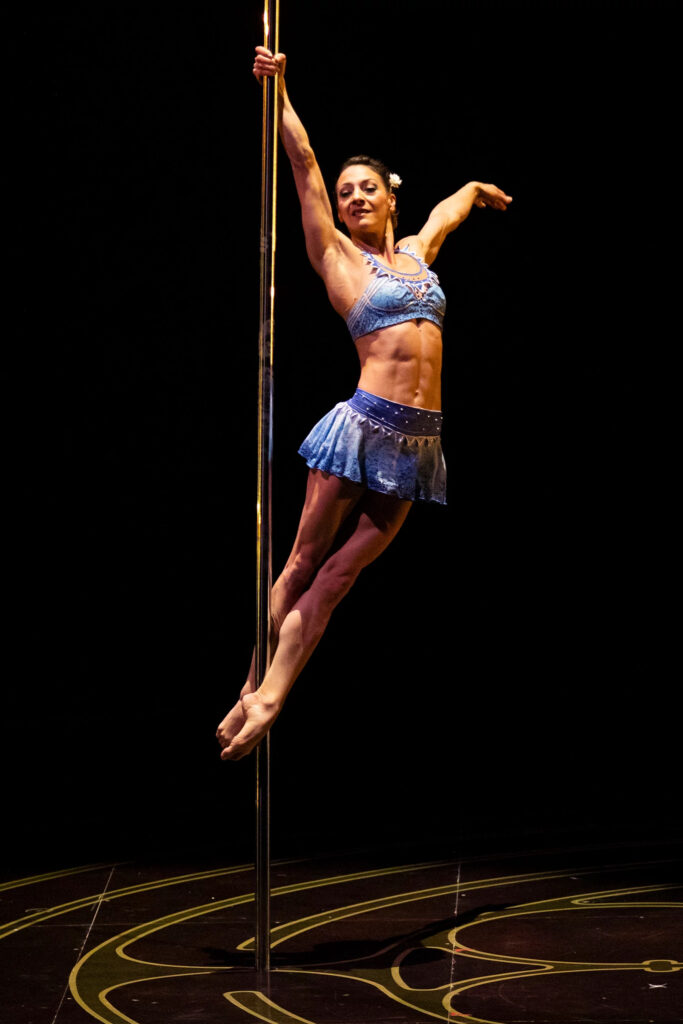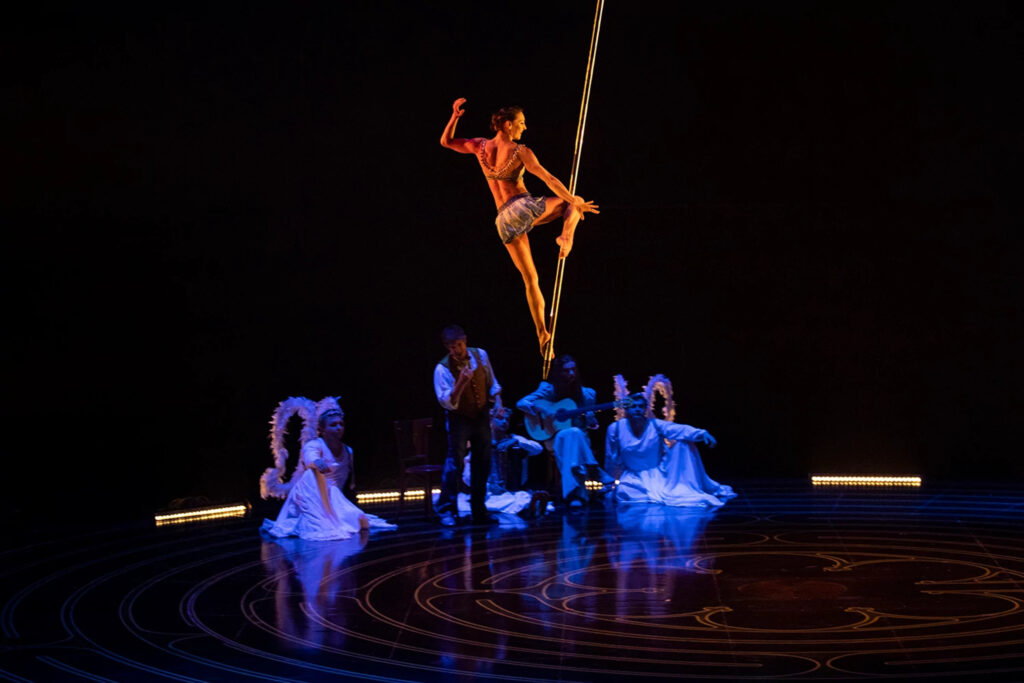Stephanie Waltman Doesn’t Just Want to Impress You. She Wants to Move You.
By Elizabeth Brignac. All photos courtesy of Cirque du Soleil.
Cirque du Soleil’s “Corteo” is coming to Raleigh this week (August 8-11). The show includes Stephanie Waltman’s suspended pole aerial acrobatic act—one developed specifically for the traveling show, which must adapt to conditions at different stadiums rather than being able to rely on consistent conditions at a stationary location.
In the suspended pole dance, the pole is lifted off the ground and moves back and forth above the stage as the dancer performs. It’s an extraordinary act, combining the grace of ballet with the athleticism of aerial gymnastics.
The experience can be intense. The show moves each week. Training must be carved out of stadium time that isn’t being used in performance, and performers sometimes do up to three shows a day.
So how does someone learn to do an act like this? And what is it like to perform it? Waltman has been developing this act with Cirque du Soleil since 2017, and she began performing it in 2018. She made time for an interview after training last week. Here are some excerpts of our conversation.
Q: I read in your bio that you moved from being a dancer to being an aerial acrobatics performer. Can you describe how you went from being one to the other?
A: I studied ballet and I wanted to dance. I started contemporary (dancing), and I was hired at a famous cabaret in Paris called Crazy Horse. I was able to travel with the cabaret, and I worked in Vegas. They had a show at this time called “La Femme” at the MGM Grand Hotel, and over there, I saw a girl performing silk (an aerial silk performance) one night, and I was like, “Oh my God! This is wonderful!” I had never seen that in my life. When I went back to Paris, I found a trainer to give me classes. It took me a while, but when I was still working with the cabaret, on my days off, I was going to train in the circus school.
After a year, I got my first contract as a performer, an aerialist, and I loved it very much. It was way more to me than dance. It was like I was able to dance on the air. And since then, I have been working as an aerialist.

Q: So you trained for a year before you got your first contract?
A: I would say for a good year, every day, maybe five days a week for a couple of hours. I didn’t have any (upper body) strength. I was a ballerina, so my arms weren’t like this at all. It was a big necessity. I learned that this is my safety in the air. If I cannot do a chin up or if there is some (problem) going on, I need to have upper body strength. Yeah, it was the most difficult thing for me.
Q: What other aerial acrobatics acts have you done besides the suspended pole act?
A: So I started with silk.
Q: That must have been wonderful—getting to do a silk performance after having been so inspired by it.
A: Absolutely. Yes. It was a very beautiful sensation. I remember. And I did a duo strap performance. I did some hoop–not my favorite, the hoop. I did some Spanish web. I started doing the trapeze as well, for upper body strength. My coach was telling me the trapeze is the first apparatus you have to work on to build your strength, so I did that. The pole routine came last–I would say nine years ago.
Q: Did you develop your act, or did “Corteo” develop it?
A: This show was previously in the big top. For the song where I perform right now, there was another act, but due to technical issues, the act was not able to go in the arena (version of the show). So they decided to bring in a new act for the transformation of the show in the arena version.
Q: So did you develop that act yourself or work with a director?
A: Both. I had two choreographers – one artistic and one acrobatic. So I arrived with my material and I showed them what I wanted to put (in the show). And they decided afterwards, “Okay” or “We don’t like it,” or sometimes we tried to find some new transition together. But it was group work that I loved. It was a very beautiful experience. It was one of the best experiences in my career. I loved it. I would like to do it again if I have the chance. But I already did once, and it’s already good.

Q: Are there other suspended pole dance acts out there?
A: You will see the suspended pole in a few other shows, but the pole is covered. So the specificity of “Corteo’s” pole is that there is no cover on it. It’s actually like a normal pole on the ground. But I fly with it in the air.
Q: What kind of cover is on the other suspended pole dancing poles?
A: Now people are covering poles with rubber or tape. They feel more comfortable in the air because the grip is better.
Q: So has the act changed at all over time, or has it stayed the same as it was when you first developed it?
A: Some tricks have changed because I have gotten more confident. So I changed a little bit, or with some stuff, I said, “Oh, I don’t like it anymore.” So it’s something I work at on the side with my head coach. And when it is ready, we show it to the artistic director, and if the artistic director likes it, I am able to put it in the show. But it’s not something like, “Oh, today, I’m going to do that!” I cannot do that because there are so many people involved when I perform. There is stage management, the automation, the lighting—everybody needs to know what I’m doing. So if I decided to do something completely different, I would be in trouble.
Q: What team is involved with your act? With whom do you work most closely?
A: Stage management and automation. And rigging as well. These three teams. Because when I’m on stage, the pole moves because the stage management is telling automation, “Okay, this is the moment when the pole needs to move. So they push the button. So it’s group work.
Q: So everybody has to be very precise, or it won’t work.
A: Yeah, they know my act super well. They know when I don’t do something or there is something going on. They know right away. They know the act perfectly. This is very important.
Q: So there has to be a lot of trust.
A: Yes. There’s a lot of trust, yes.

We spoke a bit about how difficult the traveling schedule can be. Waltman’s husband, a former “Corteo” crew member, no longer travels with the show, so Waltman only sees him two weeks of every two months on her time off from touring, which is hard. And, while the constant traveling leads to a deep sense of family among the Corteo crew and performers, it does take its toll. But for Waltman, so far, the experience has been worth it.
Q: Can you tell me a little bit more about why you love what you do? What is it about this work that you enjoy so much?
A: I came from dance, and I didn’t know about the circus industry at all before, and I feel very lucky to choose to (try it) and be successful. And I feel very honored, specifically righty now, to be on “Corteo” and have a solo act. I never thought I would be able to do that–and specifically, to perform alone onstage with Cirque du Soleil. It was one of my goals, and I made it! I still feel very lucky.
I like to give emotion to the audience. This is what I love the most–not showing a technique performance, but for me, a nice performance, what touches me the most when I watch a show, is to see something beautiful, nicely done, with a good technique–but with emotion. If there is something technically done, but there is no emotion, it’s not going to touch me. I love to touch people. Onstage, it is what I try to do almost every night.
To see Waltman’s performance, you can attend “Corteo” when it is in Raleigh, August 8-11. Learn more and buy tickets here.

